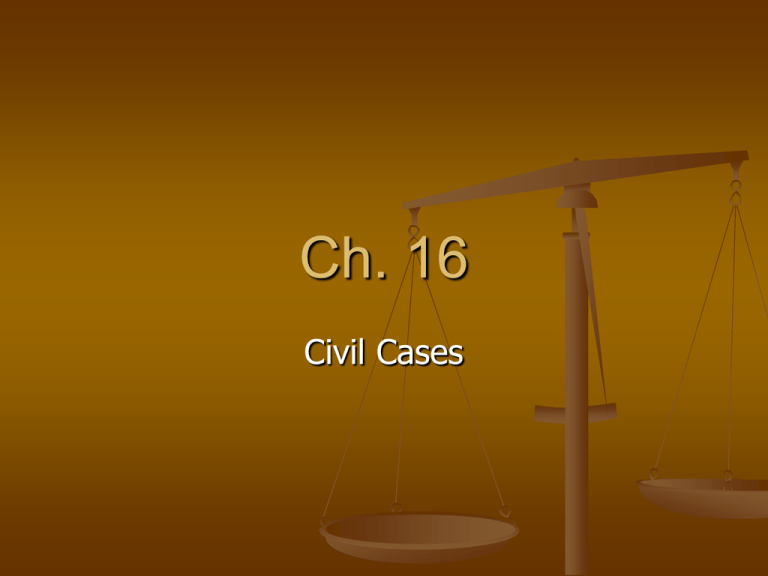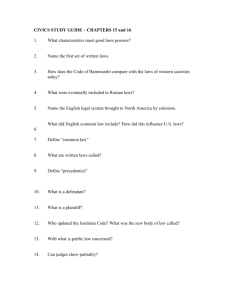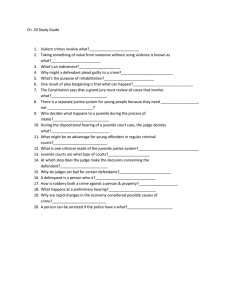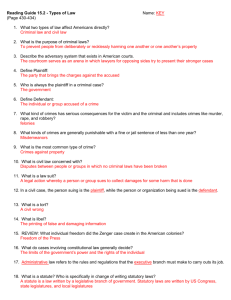Ch. 16 Civil Cases
advertisement

Ch. 16 Civil Cases Types of Civil Lawsuits In civil cases the plaintiff, or party bringing a lawsuit, claims to have suffered a loss and usually seeks damages (money from the defendant) The defendant, or party being sued, argues either that the loss did not occur or that the defendant is not responsible for it. Types of Civil Lawsuits Lawsuits involving a few thousand dollars or less are often handled in a small claims court, where people act as their own attorneys. Lawsuits may involve property disputes, breach of contract, or divorce. Negligence suits are filed when a person has been injured or killed or when property has been destroyed because someone else has been careless or negligent What Happens in a Civil Case? A lawsuit starts when the plaintiff’s lawyer files a complaint, or formal statement naming the plaintiff and defendant and describing the nature of the suit. The court then sends the defendant a summons, a document telling him of the suit and requiring him to appear in court at a certain time Steps in a Civil Case The defendant may respond by having his lawyer file an “answer” to the complaint The answer may admit to the charges or deny responsibility. The complaint and answer together are called the pleadings. Steps in a Civil Case During the discovery process before the trial, both lawyers check facts and gather evidence by questioning the other party and witnesses. The time to build a case for your client Steps in a Civil Case The judge may call a pre-trial conference with both parties. If the case is weak, the plaintiff may decide to drop the lawsuit. If the case is strong, the defendant may offer a settlement of some amount of money the defendant will have to pay the plaintiff. Steps in a Civil Case Other ways to resolve disputes may be mediation and arbitration. A trained mediator does not decide the case, but serves as a neutral party to help the two sides reach an agreement. A professional arbitrator reviews and resolves the dispute, and the arbitrator’s decision is usually binding on both parties. Steps in a Civil Case Most civil cases are settled before trial for several reasons. First, parties often prefer a negotiated outcome to the uncertain outcome of a trial. Second, it may take years for a case to come to trial. Third, trials are expensive and time consuming. Steps in a Civil Case If the parties do not settle, the case goes to trial A jury of 6 to 12 members, or more likely a judge will hear the case. First the plaintiff will present their case, and then the defendant will follow with their presentation. Steps in a Civil Case The plaintiff has to present a “preponderance of evidence”—enough to persuade the judge or jury that the defendant is likely to be responsible for the incident. This is a lower standard than prosecutors must meet in criminal cases. Steps in a Civil Case The judge or jury considers all evidence and decides on a verdict in favor of one of the parties. If the plaintiff wins, a remedy is set. If the defendant wins, the plaintiff gets nothing and must pay for the court costs. Steps in a Civil Case If the losing side believes the judge made errors or some injustice occurred, it may appeal to a higher court. Cases involving large awards are often appealed. As a result, the winning plaintiff may wait years for the money and may actually end up with nothing. Ch. 16.2: Criminal Cases In criminal law cases the government charges someone with a crime and is always the prosecution. The accused person is the defendant Types of Cases A crime is an act that breaks a federal or state criminal law and causes harm to people or society in general. Each state has a set of criminal laws, called the penal code, that spells out punishments for each crime. Felonies are the serious crimes; misdemeanors are the minor violations Types of Cases 1. 2. 3. Criminal penalties: Punish criminals and protect society by keeping dangerous criminals in prison. (Isolation) Serve as a warning to deter others from committing the same crime. Intend to help prepare lawbreakers to reenter society after their prison term ends (rehabilitation) Types of Cases In some cases, a parole board may decide to grant a prisoner parole, or early release. In these cases, the person must report to a parole officer until the sentence expires Mandatory v. Minimum/Maximum sentences Types of Cases 1. 2. 3. Three types of crimes: Crimes against people (murder, rape, manslaughter, assault, kidnapping) Crimes against property (larceny, vandalism, fraud, burglary) Victimless crimes (illegal gambling, illegal drug use) What Happens in a Criminal Case? Officers make arrests if they have witnessed a suspected crime, if a citizen has reported a crime, or if a judge has issued an arrest warrant. At arrest, the officer informs the person of 4 rights: the right to remain silent, to have an attorney present during questioning, to have a court appointed attorney if the person cannot afford one, and to stop answering questions at any time. Steps in a Criminal Case The suspect is then booked, or charged with a crime. Police take fingerprints and a photograph. At this point the suspect may call a lawyer. Steps in a Criminal Case In a few hours, the suspect appears in court. The prosecution must show the judge probable cause, or good reason, to believe the accused committed the crime. The judge then sends the accused back to jail, sets bail, or releases the suspect on his own recognizance (without bail) with the promise to appear in court when called. Steps in a Criminal Case In federal and many state courts, a grand jury decides whether to indict. In some states, a preliminary hearing is used instead Steps in a Criminal Case The defendant then appears for an arraignment and must enter a plea. If the defendant pleads not guilty, the case continues. If the plea is guilty, the defendant stands convicted and the judge determines the punishment. A plea of no contest means that the defendant does not admit guilt but will not fight the charges Steps in a Criminal Case Plea bargaining is making agreements in which the accused agrees to plead guilty, but to lesser charges. This process avoids lengthy and expensive trials and ensures a punishment. Steps in a Criminal Case Criminal defendants have the right to a jury trial, but many choose to be tried by a judge alone in a bench trial For a jury trial, both sides select potential jurors from a large pool of residents within the court’s jurisdiction. Both sides can reject jury candidates Steps in a Criminal Case The lawyers for each side outline their case in an opening statement. The prosecution and defense then present their case in turn. Both sides call witnesses who give testimony, answers given under oath. The other side may cross-examine witnesses to try to discredit their testimony. Steps in a Criminal Case Then the closing statements are given. Both sides highlight the evidence most favorable to their case. The judge then instructs the jury on the law that relates to the case. Steps in a Criminal Case The jury will then go off to discuss the case. The jury chooses a foreman to lead the discussion Deliberations are secret and have no time limit. Then comes the vote. Steps in a Criminal Case A guilty verdict means that the jury found the evidence convincing “beyond a reasonable doubt.” Most states require an unanimous vote Acquittal is a vote for not guilty Steps in a Criminal Case If the jury cannot decide on a verdict, the judge declares a hung jury and rules a mistrial. The prosecution must then decide whether to drop the charges or retry the case. Steps in a Criminal Case If the verdict is guilty, the judge sets a court date for sentencing Sometimes the jury recommends a sentence. More often, the judge decides the sentence. Sentences often specify prison time, but may include fines or community service work Steps in a Criminal Case The defense often appeals a guilty verdict The 5th Amendment prohibits double jeopardy from the prosecution. Ch. 16.3: Young People and the Courts In most states, anyone under age 18 is considered a juvenile—not yet legally an adult. Our system treats young people who commit crimes—called juvenile delinquents— somewhat differently from adults. Older juveniles charged with serious crimes, may be tried as adults Causes of Juvenile Delinquency Factors such as abuse, neglect, emotional or mental problems, and poverty contribute to juvenile delinquency. However, many children with these risk factors never have trouble with the law, while children from all backgrounds (even privileged ones) can become delinquents. Stages in the Juvenile Justice System The main goal of the juvenile courts is to try to rehabilitate, or correct a person’s behavior, rather than punish them. Cases begin with arrest or petitions to the courts filed by school administrators, store managers, or others. Parents may also petition This means that children can be put into the juvenile justice system without having been accused of a crime. Stages in the Juvenile Justice System Before reforms in the late 1800s, juvenile offenders received the same sentences and were sent to the same prisons as adults. Today, juvenile courts try to do whatever is best for the young person. Stages in the Juvenile Justice System In cases of neglect or abuse by caregivers, a court may place youths in foster homes. Delinquency cases involve crimes Other cases involve actions that are considered illegal only for juveniles, such as running away or maybe curfew violations. Stages in the Juvenile Justice System When a juvenile is arrested, police notify the parents or caregivers. The child may be sent home or placed in juvenile detention until time to appear in court. In non-violent cases, juveniles may be diverted away from the court and into special programs, such as counseling, job training, or drug treatment. Stages in the Juvenile Justice System A judge may hold a detention hearing to determine whether the juveniles might be dangerous to themselves or others If so, the juvenile may remain confined. Stages in the Juvenile Justice System The next stage is the preliminary hearing to determine probable cause Is there enough to take this to an actual trial; the evidence has to be weighed Stages in the Juvenile Justice System The trial is less formal than in adult court. Only the parties involved may attend Both sides call and cross-examine witnesses; no jury involved; the judge decides whether the young person is delinquent or non-delinquent Stages in the Juvenile Justice System The system tries to protect juveniles by keeping their identities and criminal records secret. In some cases, records may be erased when the offender becomes an adult. Some states are experimenting with peer juries for the sentencing stage, if the defendant agrees. Stages in the Juvenile Justice System If a juvenile has been found delinquent, the court holds a hearing to decide the sentencing. Delinquents may be sent home with a stern lecture or placed in a special training school, reformatory, treatment center, or teen shelter. Stages in the Juvenile Justice System If the young people attend school and obey their caregivers during the probationary period, the charges will be removed from their record. Juveniles who were neglected may become wards of the court until they are adults. Judges may place juveniles with serious mental or emotional problems in a hospital or institution. Supreme Court Rules Gerald Gault, age 15, had been sentenced to 6 years in a reformatory for making indecent telephone calls to a neighbor. His parents were not informed of his arrest. He had no attorney present and the neighbor was never questioned Supreme Court Rules The Supreme Court overturned the ruling in the 1967 case In re Gault and established rules for juvenile criminal cases. Juveniles have the right to counsel, the right to confront witnesses, and the right not to be forced to incriminate themselves.






